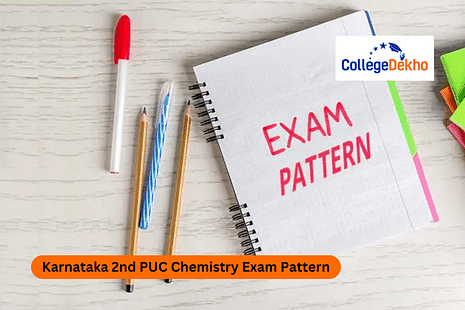

Never Miss an Exam Update
Karnataka 2nd PUC Chemistry Exam Pattern 2025
: The Karnataka 12th Chemistry question paper will be of 100 marks, out of which 70 marks and the remaining 30 marks will be allotted for the practical exam. There will be 40% remembering, 30% understanding, 17% apply, and 13% Hots type of questions in the Karnataka 2nd PUC question paper. Students will get 1 marks MCQ type questions along with short and long answer type questions of 2, 3, 4, or 5 marks.
Karnataka 2nd PUC Chemistry syllabus 2025
consists of 16 units, from where 6 chapters were deleted last year.
The
Karnataka 2nd PUC Time Table 2025
will be issued in January 2025 on the official website and the final exams will be conducted in March 2025. Read the article further to know more on the Karnataka 2nd PUC Chemistry Exam Pattern 2025.
Karnataka 2nd PUC Chemistry Exam Pattern 2025
The unit-wise Karnataka 2nd PUC Chemistry Blueprint 2025 has been tabulated below along with the detailed marking scheme for each chapter:Unit Name | Topics | Marks |
|---|---|---|
Unit 1: The Solid State | Nil | -- |
Unit 2: Solutions | 2.1 Types of Solutions 2.2 Expressing Concentration of Solutions 2.3 Solubility 2.4 Vapour Pressure of Liquid Solutions 2.5 Ideal and Non-ideal Solutions 2.6 Colligative Properties and Determination of Molar Mass | 13 |
Unit 3: Electrochemistry | 3.1 Electrochemical Cells 3.3 Nernst Equation 3.4 Conductance of Electrolytic Solutions 3.5 Electrolytic Cells and Electrolysis (excluding the elementary idea of laws of electrolysis | 14 |
Unit 4: Chemical Kinetics | 4.1 Rate of a Chemical Reaction 4.2 Factors Influencing Rate of a Reaction 4.3 Integrated Rate Equations | 13 |
Unit 5: Surface Chemistry |
5.1 Adsorption
| -- |
Unit 6: General Principles and Processes of Isolation of Elements | Nil | -- |
Unit 7: p-block elements | Nil | -- |
Unit 8: d and f Block Elements | 8.1 Position in the Periodic Table 8.2 Electronic Configurations of the d-Block Elements 8.3 General Properties of the Transition Elements (d-Block) 8.5 The Lanthanoids: Electronic configuration, oxidation states, Llanthanoids contraction, reasons and consequences. 8.6 The Actinoids; Actinoid contraction 8.7 Some Applications of d- and f-Block Elements | 11 |
Unit 9: Coordination Compounds |
9.1 Werner's Theory of Coordination Compounds
| 12 |
Unit 10: Haloalkanes and Haloarenes | 10.1 Classification 10.2 Nomenclature 10.3 Nature of C–X Bond 10.4 Methods of Preparation 10.5 Physical Properties 10.6 Chemical Reactions | 09 |
Unit 11: Alcohols, Phenols and Ethers | 11.1 Classification 11.2 Nomenclature 11.3 Structures of Functional Groups 11.4 Alcohols and Phenols 11.6 Ethers | 12 |
Unit 12: Aldehydes, Ketones and Carboxylic Acids | 12.1 Aldehydes and Ketones: Nomenclature, nature of carbonyl group, methods of preparation, physical and chemical properties, mechanism of nucleophilic addition, reactivity of alpha hydrogen in aldehydes, uses. 12.2 Carboxylic Acids: Nomenclature, acidic nature, methods of preparation, physical and chemical properties; uses. | 14 |
Unit 13: Amines | 13.1 Amines: Nomenclature, classification, structure, methods of preparation, physical and chemical properties, uses, identification of primary, secondary and tertiary amines. 13.2 Diazonium salts: Preparation, chemical reactions and importance in synthetic organic chemistry. | 08 |
Unit 14: Biomolecules | 14.1 Carbohydrates - Classification (aldoses and ketoses), monosaccharides (glucose and fructose), D-L configuration oligosaccharides (sucrose, lactose, maltose), polysaccharides (starch, cellulose, glycogen); Importance of carbohydrates. 14.2 Proteins -Elementary idea of - amino acids, peptide bond, polypeptides, proteins, structure of proteins - primary, secondary, tertiary structure and quaternary structures (qualitative idea only), denaturation of proteins; enzymes. Hormones - Elementary idea excluding structure. 14.3 Vitamins - Classification and functions. Nucleic Acids: DNA and RNA. | 09 |
Unit 15: Polymers | Nil | -- |
Unit 16: Chemistry in Everyday Life | Nil | -- |
Also Check Karnataka 2nd PUC Chemistry Sample Paper 2025
Karnataka 2nd PUC Chemistry Deleted Chapters 2025
The chapters that were removed last year from the syllabus are as follows:Unit Name | Page No. | Deleted Topics |
|---|---|---|
Unit 1: The Solid State | 1–34 | Full chapter |
Unit 5: Surface Chemistry | 123–148 | Full chapter |
Unit 6: General Principles and Processes of Isolation of Elements | 149–169 | Full chapter |
Unit 7: p-block elements | 170–214 | Full chapter |
Unit 15: Polymers | 433–446 | Full chapter |
Unit 16: Chemistry in Everyday Life | 447–463 | Full chapter |
Karnataka 2nd PUC Chemistry Question Paper Blueprint 2025
The Karnataka 2nd PUC question paper will have a total of 49 questions out of which 35 questions are to be answered. The overall marks weightage of the question paper will be 70 marks. Students will be given 3 hours to write their answers.
- The question paper will be divided into 5 parts.
- All the 5 parts are compulsory.
- In Part A, there will be 20 questions. Each question will carry 1 mark.
- Part B will have 6 questions. Each question will carry 2 marks.
- Part C will have 10 questions. Each question will carry 3 marks.
- Part D will have 7 questions. Each question will carry 5 marks.
- Part E will have 6 questions. Each question will carry 3 marks.
- Questions in all parts had internal choices except Part A. Students can download Karnataka 2nd PUC Chemistry Previous Year Question Papers to understand the format of the question paper.
| Question Paper Part | Question Type | Number of Questions | Marks |
|---|---|---|---|
| PART - A | MCQ’s | 15/15 | 15/15 |
| PART - A | Fill in the blanks | 05/05 | 05/05 |
| PART - B | Short Answer (SA = 02 Marks) | 03/06 | 06/12 |
| PART - C | Short Answer (SA = 03 Marks) Inorganic Chemistry | 03/06 | 09/18 |
| PART - C | Short Answer (SA = 03 Marks) Physical Chemistry | 02/04 | 06/12 |
| PART- D | Long Answer (LA = 05 Marks) | 04/07 | 20/35 |
| PART - E | Short Answer (SA = 03 marks): Numerical problems | 03/06 | 09/18 |
| Total | 35/49 | 70/115 |
The Karnataka 2nd PUC Chemistry Question Paper will comprise questions that are based on Remember, Understanding, Apply, and Hots. The table below contains the percentage and marks that every objective will carry:
| Objectives | Number of Questions | Marks | Percentage |
|---|---|---|---|
| Remember | 20 | 46 | 40% |
| Understanding | 15 | 35 | 30% |
| Apply | 07 | 19 | 17% |
| Hots | 07 | 15 | 13% |
| Total | 49 | 115 | 100% |
Students must go through the Karnataka 2nd PUC Chemistry exam pattern and syllabus. This will help them prepare better for the exam and score better marks in Karnataka 2nd PUC Result 2025 .
FAQs
No, the Karnataka state board will soon release the Karnataka 2nd PUC Chemistry Exam Pattern 2024-25. It will be released on its official website along with the syllabus.
Was this article helpful?



















